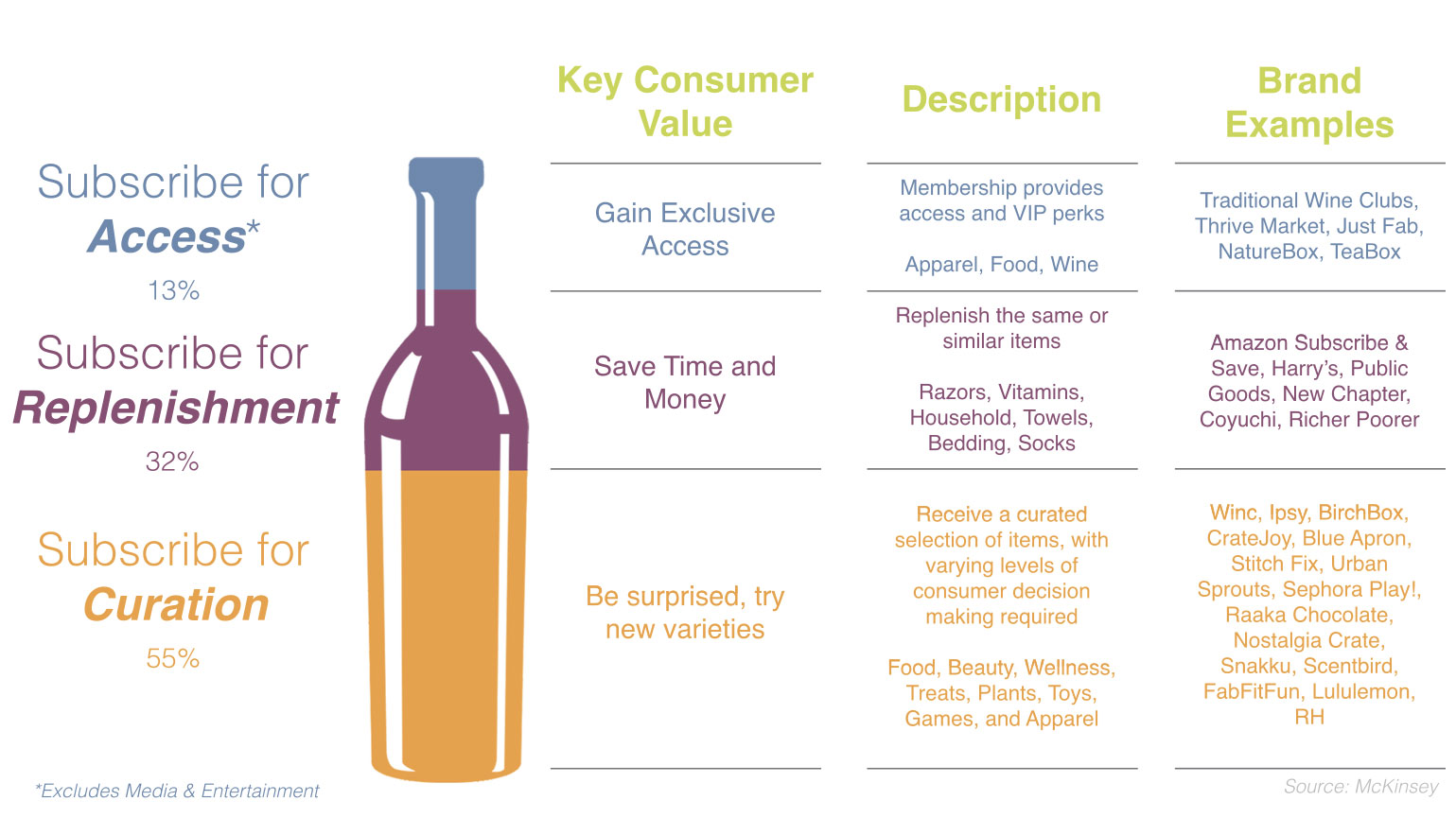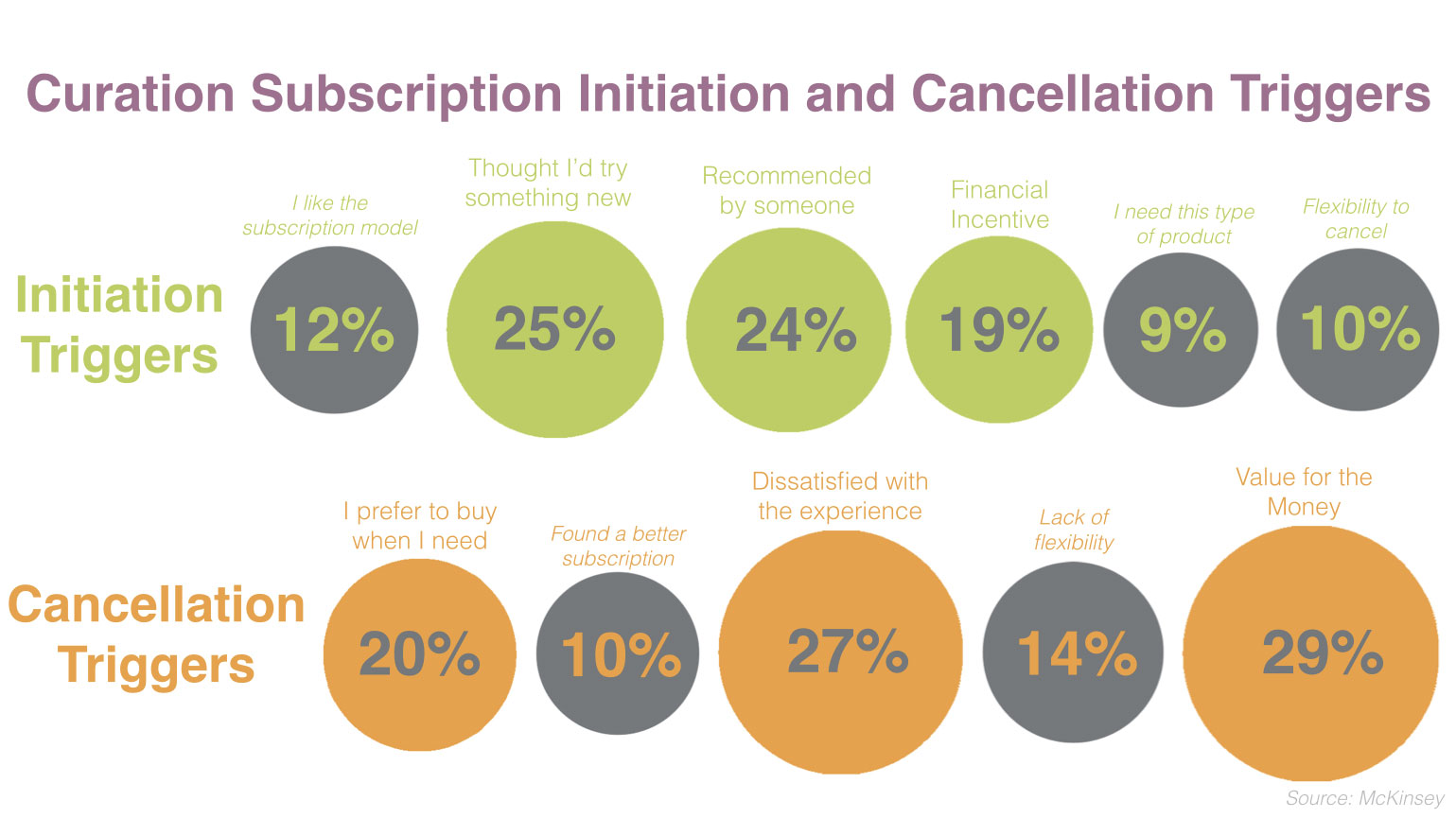
Is Your Wine Club Keeping Up with Modern Subscription Models?
By Gaynor Strachan Chun
If COVID taught us nothing, it is that re-occurring sales are key to survival, and that customers are surprisingly resilient and creative with changes in channel or delivery methods. The post-COVID conversations around alcohol distribution include the so-called “fourth tier” of instantaneous delivery (Instacart), and online options like buy online now and pick up in store later (BOPUIS).
At the same time as these channels evolve, the elasticity of the traditional Wine Club is stretched as well. It is now estimated that the average person is a member of two re-occurring subscriptions and 35% belong to three or more.
Why are we moving so swiftly into a subscription economy? For wine, it’s a perfect storm of three factors.
1. Our culture of consumerism is changing.
The mindless and haphazard consumerism of old is giving way to thoughtful and curated purchases where the brand and its products add value to our lives. This significant change in consumer thinking and behavior has fueled, among other things, the rocketing growth of subscription models. Subscriptions meet the needs of concerns such as waste reduction and finding quality time with family. And, wine clubs need to catch up to remain relevant, resonant and competitive.
2. We’re curious.
The primary consumers for subscriptions are young urbanites, 25-44 years old. What they have in common is a sense of discovery. They want to try new things and like being presented with options. Most subscriptions offer monthly mystery boxes, surprises, or trial sizes, giving customers a new product to try. This brings an additional level of excitement to the unboxing experience and gets consumers to expand their product knowledge and preferences.
3. We don’t value “saving” like our parents did.
Our parents wanted the lowest price so they could show off the best quality brand they could afford. The new consumer is interested in saving time. The financial incentive is there, but you can’t just give a small discount to this group and expect to call it a day on your benefits alone.
Only a few years ago, the model was simple. You joined a club to gain exclusive access to products and VIP perks. These membership clubs were found in categories such as luxury apparel, food and wine.
However, with the onslaught of COVID, the dramatic increase in E-commerce, digitally native brands, and the growing influence of the Millennial mind-set and their expectations as consumers, the world of “clubs” has evolved.
The consumer has moved on. Have you?
3 Subscription Models Have Emerged

A McKinsey Report lays out the current state of subscription models very clearly. What jumps out is that the traditional model of Subscribe for Access has been usurped by the newer models of Subscribe for Replenishment and Subscribe for Curation. And, while Subscribe for Replenishment accounts for a healthy one third of subscriptions, it is not a relevant category for wine clubs given its focus on essential household, wellness and grooming products. Which leaves the wine industry needing to evolve the traditional wine club model, beyond offering a choice here or there, to compete within Subscribe for Curation.
What does this mean? Successful Subscribe for Curation offerings have the following imperatives as the foundation of the subscription offered:
- Move from a focus on transactions to long-term relationships
- Shift from acquisition focus to retention
- Shift from selling products to selling experiences
- High levels of personalization, flexibility and surprises
- A highly anticipated unboxing experience
Impeccable customer service
In other words, focusing on delivering a great experience that puts the consumer in charge of what they order and keeps them coming back for more by including gifts, exclusive content, and other surprises.
Attracting New Subscribers and Keeping Them
Wineries traditionally relied on converting their tasting room visitors to club members. However, attracting members who will never visit your tasting room is an increasingly important consideration in any conversation around future revenue growth. We all know a subscription model is good for business – it delivers increased and predictable revenue, contributes to savings in customer acquisition spending, increases loyalty and lifetime value, and can reduce operational costs due to predictable demand. Therefore, understanding the triggers that cause a potential subscriber to sign-up and those that cause them to cancel is a critical component when evolving your current club model to a subscribe for curation model.
The initiation triggers point to consumers’ desire to discover new things and especially, new things someone else recommends. A strong social media presence and refer a friend incentives are key to this discovery process. Cancellation triggers hinge on the experience – either the overall experience or the perceived value for money vis-à-vis the experience. Given the need to elongate subscription lifetime values, every step of the experience offered needs to be executed at the highest level. Consumers not only expect it, but they also know what a great experience feels like. After all, the average consumer now has somewhere between 3 and 10 subscriptions (excluding media and entertainment.

Less is more
There is a reason most companies only offer 3 levels of subscription. Our brains think in threes. More choices are not better. They can cause confusion, delay the decision, or result in the potential member walking away.
Rather than thinking about the subscription levels from your product line-up perspective, structure the levels from the consumer’s perspective – I want you to curate this for me, I want the option to add from a defined list, I want to make all the choices for myself. This will help reduce the number of levels and increase conversion.
Looking Ahead
“The measure of intelligence is the ability to change”
-Albert Einstein
There’s never been a greater time than now to be open to evolving our business models. Changes in demographics and consumer trends have been coming for years and wineries who aren’t willing to look at adapting their Wine Club programs leave themselves open to becoming less relevant with consumers as the attitudes and behaviors continue to evolve.
Gaynor Strachan Chun is the Director of Strategy at WineGlass Marketing, the leading full-service and award-winning marketing agency for the adult beverage industry. The firm, now in its tenth year, is based in downtown Napa and supports domestic and international wine and spirits clients with B2B and DTC marketing in digital and traditional channels. For the past two consecutive years, Inc. Magazine recognized WineGlass Marketing as the only Napa company listed in the top 250 hyper-growth tier of the “5000 Series California’s Top Companies”. WineGlass Marketing is also admired by the community, winning the North Bay Bohemian “Best Creative Agency” spot for both 2021 and 2022 and being honored as Napa’s “Best Company to Do Business With” in the 2021 North Bay Business Journal. The firm’s creative strength is apparent winning top honors in the 2021 Web Awards for Best Beverage Website and a Webby Honoree for Websites in 2022. In the Internet Advertising Competition, WineGlass Marketing won Best Integrated Ad Campaign in the Beverage Category for 2021 and Best Website in the Beverage Category in 2022. In the 2022 Communicator Awards, the Agency was recognized with four trophies for marketing campaigns.
WineGlass Marketing is located at 531 Jefferson Street in Napa and can be reached online at www.wineglassmarketing.com or by calling 707-927-3334.


